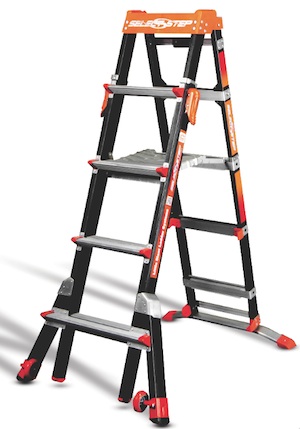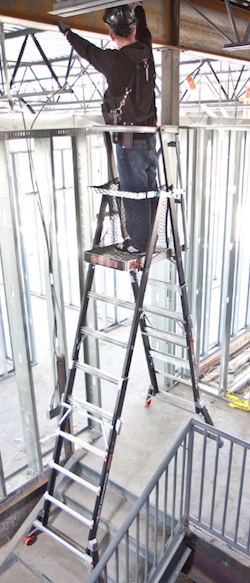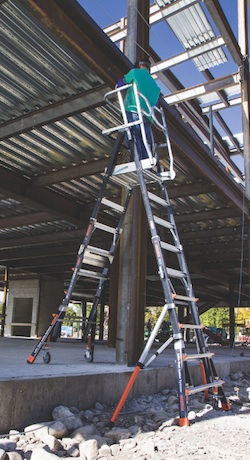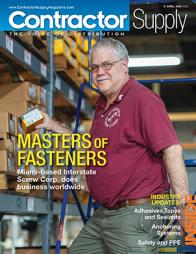Little Giant: Selling Advanced Ladder Systems
The future for ladder users.
 Everyday 2,000 people are injured in ladder accidents. One hundred of those injured will suffer a long-term or permanent disability. And every day, one person dies. Can you
Everyday 2,000 people are injured in ladder accidents. One hundred of those injured will suffer a long-term or permanent disability. And every day, one person dies. Can you
imagine the total medical, lost-time and workers compensation costs? For many large contractors and industrial companies, ladder-related accidents are the single biggest workers compensation expense. But these expenses pale in comparison to the terrible human cost; the lost fathers and mothers, sons and daughters.
Governments, contractors and insurance companies have begun to act. Many companies have put prohibitive restrictions on ladder use to prevent incidents. Turner Construction, one of the largest general contractors in the world, is pioneering a new “Ladders Last” program that requires operators to obtain written permission from an onsite safety supervisor before they can use a ladder on the job.
Ladder-related incidents accounted for a significant portion of a contractor’s accident expense. It is quickly coming to the point where contractors will say “enough
is enough.”
Other companies are taking a different approach. Another of the country’s largest contractors now requires one person to hold a ladder while an operator works on it—two people to do the job of one—an obvious decrease in production, but in this
company’s estimation, still less costly than a serious fall.
 The Future for Ladder Retailers
The Future for Ladder Retailers
Manufacturers and distributors of climbing products must take note. Industrial and construction companies are re-evaluating the risks and benefits of traditional ladders. In this kind of climate, how do you stay relevant? How do you stand out?
You know your customers’ questions before they ask them. You offer the services and products others can’t offer or are unwilling to offer. You introduce your
customers to innovation.
The “Serve, Then Sell” Mentality
These shifting attitudes on safety and climbing equipment will be very difficult to navigate with the ladders of the past. But there are several very effective tactics STAFDA members can use to bring customers real value.
We’d like to focus on three: live safety training, free online safety training and disruptive product innovation.
1. Live Ladder Safety Training Events. Industrial and contractor companies are required to train ladder users on a regular basis. Continuous training is one of the most difficult, time-consuming parts of a safety professional’s job, but effective safety training is absolutely critical to preventing injuries and saving lives. Safety professionals know this, and they struggle admirably to do the best they can, but many feel like they’re losing the battle.
“We needed help! Even with regular training, getting our people to slow down even a little to think about safety can be difficult,” said Nate Brimhall, director of safety of CCI Mechanical in Salt Lake City, Utah. “Sometimes the standards themselves are the challenge. There have been times when it was very difficult to complete our job in compliance with opposing regulations.”
A STAFDA house with the “Serve, then sell” mentality can transform itself into a vital resource by offering this service to its customers. And it doesn’t have to come at great expense. There are STAFDA partners that will help you provide this service.
 Little Giant Safety, the industrial arm of Little Giant Ladder Systems, works directly with safety officers to train professional ladder users. Dave Francis, Little Giant’s national safety director and a 30-year veteran of the industry, travels all over the country training at ladder safety events at large companies and distributors. Little Giant provides this service free of charge, using these events to train users and to show safety officers that there are safer non-traditional product options out there.
Little Giant Safety, the industrial arm of Little Giant Ladder Systems, works directly with safety officers to train professional ladder users. Dave Francis, Little Giant’s national safety director and a 30-year veteran of the industry, travels all over the country training at ladder safety events at large companies and distributors. Little Giant provides this service free of charge, using these events to train users and to show safety officers that there are safer non-traditional product options out there.
When planned and executed well, these events can be huge serve-then-sell opportunities. Little Giant recently teamed with fall-protection experts from Capital Safety to provide ladder safety training events in Denver and Salt Lake City. Over 500 people attended and were certified at these events, and the distributor hosting the event said, “We’re not sure yet how we’re going to follow up on this many leads, but we’ll take them!”
2. Free Online Safety Training. The American Ladder Institute (ALI), the industry’s governing body, has developed four online ladder safety training modules at www.laddersafetytraining.org. This free online service site provides a pre-test, an informative training video, a post-test and allows for printing of a certificate of completion. The site also allows managers to track the training progress of their employees.
“After every training event I do, I tell the safety people about the ALI training modules,” said Dave Francis of Little Giant. “It’s a great way to follow-up and reinforce what we do at the live events. The ALI has created a great resource, but the problem is, hardly anyone knows it’s there.”
This program is another free service that a knowledgeable STAFDA distributor can promote to customers.
3. Identifying Problems and Providing Solutions. Although it is extremely important, training alone is not enough. Well-trained operators fall from traditional ladders every day — 2,000 each day, in fact. We can usually boil it down to one of three reasons:
A. Repeatedly handling heavy traditional ladders
B. Using the ladder incorrectly and
C. Over-reaching.
These are the key problems contractors have with traditional ladders. These are the reasons behind “Ladders Last” and similar movements away from ordinary ladders.
Understand these safety problems and provide solutions to them and you will be an invaluable partner for your customers.
A. Handling Injuries
Back and shoulder injuries caused by moving and setting up heavy ladders are usually not too serious, but they are by far the most common kind of injury so they account for the greatest expense, as much as $75,000 per incident in lost time and actual costs. Better training in handling the ladder and properly setting it up can help, but this is actually answering the wrong question.
 Little Giant’s solution was to work with its suppliers to re-engineer traditional fiberglass technology. Little Giant’s exclusive fiberglass-resin composite reduces the weight
Little Giant’s solution was to work with its suppliers to re-engineer traditional fiberglass technology. Little Giant’s exclusive fiberglass-resin composite reduces the weight
of an extension ladder by up to 25 percent without affecting the strength or durability of the ladder. One large company has reported a 30 percent decrease in handling injuries since switching to this lighter industrial ladder, which is available only through distribution.
B. Falls Caused by Incorrect Use
No matter how well you train them, people take shortcuts. They sacrifice safety for speed. This kind of injury most commonly occurs when an operator stands on the top rung or top cap of a stepladder. Nate Brimhall of CCI explains, “Because keeping employees off the top rung is an ongoing struggle, we asked Little Giant for help.”
Little Giant engineers offered a simple, but effective solution — the Select Step fiberglass adaptive stepladder. They created an adjustable-height stepladder and removed the top rung, which prevents the operator from stepping to the top cap.
“It was so simple, and exactly what we needed,” said Brimhall. “The infractions stopped immediately. We don’t buy traditional stepladders any more. It’s safer, our people love it and we’ve replaced three ladders with one that offers easier handling and storage and which is safer and more efficient.”
C. Over-Reaching
This is the most serious type of ladder accident, often resulting in disability or death. Over-reaching is just human nature. Instead of climbing down and moving the ladder over a few feet, we reach just a little farther. These accidents are by far the most costly, both in human life and in monetary expense; so it stands to reason that the rules enacted to prevent them are the most severe — so severe in some cases that they can bring a project to a grinding halt.
Some government agencies and companies now require operators to tie off with a lifeline when working above six feet — and a few at four feet.
“It has been challenging,” said Jason Cuskelly of Big-D Construction, a leading western contractor. “We have found ourselves on jobs where tying off was very limited, using a lift was not always possible and alternate methods were very expensive and time-consuming. It made compliance, keeping employees safe and maintaining work flow
very difficult. We needed a better solution.”
During meetings with Little Giant, Big-D shared its specific needs. This collaboration led to the creation of the Little Giant Aerial Safety Cage, a mobile, adjustable work platform that encloses the operator in a secure guardrail, satisfying the tie-off requirement. Thanks to this joint effort, the Cage is now in service all over the world and by companies such as Disneyland and Boeing to Exxon Mobil and contractors all over the country.
An Opportunity for Growth
The work of bringing each father or mother, son or daughter home each night is not just noble and important; it is intensely personal to those who do it. To stand out, to stay relevant, STAFDA distributors must be part of this movement. Attitudes toward traditional ladders are changing rapidly, and the needs of your customers are changing along with them.
By providing safety training and service that customers can’t get anywhere else and next-generation equipment they can’t find anywhere else, STAFDA members have the
opportunity not only to weather the coming storm but also to thrive in it. CS
H. Arthur “Art” Wing is president and vice chairman of Little Giant Ladder Systems. He can be reached at the website www.ladders.com. Dave Francis, Little Giant’s national safety director, can be reached by email at dave@ladders.com.















